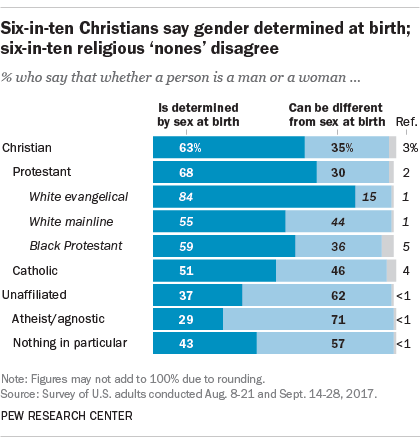Statistics about Religion and Trans People
As a social worker and a queer human, I prefer to look for strengths and opportunities. I dislike "proving" my struggle with statistics. I believe my narrative should stand on it's own. However, assignments are assignments, and I think there is much to be understood by contextualizing my thoughts in larger statistics.

Let's start with a chart of how religious people understand the trans community. (I use trans here, because agender is a specific identity rarely measured in survey, and other gender identities are increasingly understood as part of the trans umbrella.)

First - the issues I see with this data. This is a Christian-centric piece of data that does not authentically grapple with non-Christian religions. This data that shows an external perspective - how Christians and atheists understand the trans community. While this is important to contextualize the voice and opinions I will share, it is not the perspective I am interested in exploring here. It certainly affects trans Christians that 63% of their fellow believers misunderstand their reality, and trans atheists/agnostics experience the opposite. However, I am interested in trans folks own thexology, that is, how they view themselves in relation to religion or spirituality or divinity or nothingness.
The Christian magazine Soujourners provides reflections on 2015 US survey data about the trans community, in a more internal way. (https://sojo.net/articles/7-things-largest-ever-survey-transgender-people-tells-us-about-our-churches) Both data examples are US centric, though I hope to explore global perspectives as well throughout the blog. I would like to highlight the following points:
1. "Most [American] trans people have experienced life in a community of faith."
66% of trans respondents have been a part of a faith community at some point.
(This includes me.)
2. "Trans people are afraid of religious rejection."
39% have left their faith communities due to fear of rejection.
(I have left, but my reasons are more complex)
3. "Trans people have a pretty good reason to be afraid"
1 in 5 trans people have been directly rejected from faith communities.
(Not me, "directly")
(Points number 4 and 5 fall into Christian-centric language and I wonder if they are misrepresenting the data. Soujourners, a Christian publication, abruptly switches out the word "faith community" for "church." I will not include these points here due to this. What of synagogues, mosques, sanghas, and meetings?)
6. "Nineteen percent of [American] transgender people are actively involved in a faith community."
(After a bizarre journey through Lutheranism, evangelicalism, agnosticism, goddess worship, and astrology I am a practicing Quaker. I fit the statistic. And I am in the minority of trans folks, as 81% are not actively involved).
This writing is for everyone, but it is about a minority of a minority. According to Williams Law Institute, .6% of adult Americans identify as trans (https://williamsinstitute.law.ucla.edu/research/how-many-adults-identify-as-transgender-in-the-united-states/). This means that I am largely exploring 18% of .6%. (Though a number of writers I will explore are spiritual thinkers not necessarily associated with a faith community, and others may be youth rather than adults)
I estimate that .1%* of the US population is trans and an active member of a religious community. No wonder I have never seen a blog speaking to my experiences. This is why my work is needed.
Though our numbers are numerically small, our voices are important. They are unique. I believe that thexology created by minorities has the ability to re-organize thought and speak truth to power.
*(conflating data from different surveys with different methods can be misleading, so this is not likely the most accurate number, but it gives us an identity of the minoritization of this group)
Comments
Post a Comment